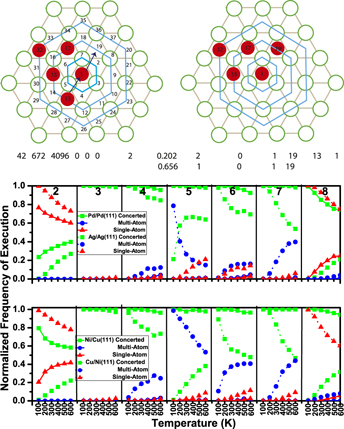Published online by Cambridge University Press: 28 March 2018

The self-learning kinetic Monte Carlo method has been shown to be suitable for examining the temporal and spatial evolution of adatom islands on the (111) surface of several fcc metals, unbiased by diffusion processes chosen a priori. A pattern-recognition scheme and a diffusion path finder scheme enable collection of a large database of diffusion processes and their energetics. A variety of mechanisms involving single and multiple atoms, and concerted island motion are uncovered in long-time simulations. In this contribution, after reviewing the methodology, we present results comparing the diffusion kinetics of two sets of homo-epitaxial and hetero-epitaxial systems: small (2–8 atom) Pd and Ag islands on the respective (111) surfaces and small Cu islands on Ni(111) and Ni islands on Cu(111). We trace the dominance of concerted motion in Pd/Pd(111) and Ni/Cu(111) and competition among concerted, multiatom and single-atom processes in Ag/Ag(111) and Cu/Ni(111) to the strength of the lateral interaction among adatoms in these systems.
Please note a has been issued for this article.